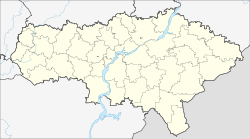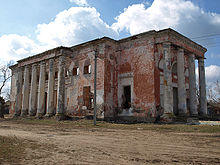Sovetskoye (Saratov)
| Urban-type settlement
Sovetskoye
Советское
|
||||||||||||||||||||||||||||||
|
||||||||||||||||||||||||||||||
|
||||||||||||||||||||||||||||||
Sowetskoje ( Russian Советское ; former German name "Mariental" ) is an urban-type settlement in Saratov Oblast ( Russia ). With 3348 inhabitants (as of October 14, 2010), Sovetskoye is the second largest town in the Raion of the same name after the administrative center of Stepnoye .
geography
Sovetskoye is located in the northwest of the Sovetsky Rajon on the Great Karaman , which marks its eastern border, and is 60 kilometers from Saratov . The federal trunk road R236 passes 20 kilometers south. The nearest railway station is in Nalivnaya (originally named after the Nahoi River), 18 kilometers away, on the Engels - Uralsk route on the Ryazan - Uralsk railway line. But only a local train stops at the station. From Saratov, Sovetskoye can be reached directly by bus 639, which runs four times a week.
Until 1918 Sovetskoye belonged to the Nowousenski Ujesd of Samara Oblast , the capital of which Samara is about 370 kilometers northeast.
Sovetskoye is 40 kilometers away from the left bank of the Volga.
history
Sowetskoje was founded on June 16, 1766 by German settlers under the name Pfannenstiel . The settlement was laid out in a meadow on the right bank of the Great Karaman, but was transferred to the other side of the river less than a year later due to flooding. In the beginning, the settlers had to live in small earth huts and get by with little land, wood and cattle. The village was also regularly attacked by nomadic Kyrgyz and Kalmyks . More than 200 settlers fell into bondage and only a few of them were freed from slavery. At the end of the 18th century the situation finally calmed down. The colony began to develop under the significantly improved living conditions. 14 windmills, a hospital and a school were built, the small Church of the Assumption of Mary was replaced by a new larger one, and the population grew until the early 1920s.
Anton Schneider's notes are dedicated to the history of the Mariental colony and are among the oldest and most important sources on the history of the Volga Germans. In his book "Mariental XVIII. - XIX. Century (Volgadeutschesgebiet)" one can find not only descriptions of the miss years and difficult lives of colonists, but also romantic verses about the idyllic other life.
The first German settlers left Mariental for the USA in August 1876. After the anti-Bolshevik uprising during the famine years (the suppression of the uprising in Mariental in April 1921 alone, there were over 550 victims) and the "German" operation 1937–1938, the German population suffered very high losses. In 1941 the Germans were deported by order of the Soviet Interior Ministry (NKVD).
After the end of the Soviet Union in 1990, many of the formerly deported Germans came to Germany as repatriates . Former Mariental residents meet today in Osnabrück , Germany .
Population development
| year | Residents |
|---|---|
| 1772 | 400 |
| 1816 | 924 |
| 1834 | 1777 |
| 1857 | 3500 |
| 1897 | 5058 |
| 1920 | 7133 |
| 1926 | 4883 |
| 1939 | 5385 |
| 1959 | 3313 |
| 1970 | 3426 |
| 1979 | 3087 |
| 1989 | 3575 |
| 2002 | 3516 |
| 2010 | 3348 |
Note: 1897 and from 1926 census data
Buildings and sights
Despite its rich history, Sovetskoye is difficult to distinguish from typical Russian villages. The old cemetery can no longer be found either. It is all the stranger that the Church, even if in a ruined state, still exists.
The parish church in Mariental was built in 1842 in the office style with a 32 meter high bell tower and 16 columns. After two wooden and one stone, it was the fourth church in the history of the settlement. The first construction work after the original project took place in early 1830. Due to errors in the project, the church looked unusual and a little disproportionate. For this reason, both the church furnishings and the building itself were later rebuilt and expanded several times. In 1860 a sacristy was added. After the Second World War the church was closed and used as a cultural center until the 1990s .
Little has remained of the once imposing church building. The interior, the tower and the roof are completely missing. Refurbishment or conversion for further use are not planned.
Personalities
- Augustin Baumtrog (1883–1937), pastor, died on Solowki
- Josef Baumtrog (1873-1921), pastor in the Civil War fallen
- Aloysius Kappes (1885–1937), pastor, sentenced to death by a special troika for "propaganda or political agitation" and "organizational activity" (Article 58)
- Franz Schiller (1898–1955), literary scholar
- Anton Schneider (1798–1867), chronicler, writer and teacher
- Adolf Bersch (1915–2010), member of the initiative group for the restoration of the German Volga Republic
See also
literature
- Homeland books of the country team of Germans from Russia, 1954–2008.
- Adolf Bersch: Between Suffering and Hope: The Fate of a Volga German. Adwerb-Verlag, 1996. ISBN 392856109X
- Anton Schneider: From the history of the Mariental colony on the Volga. Edited and edited by Victor Herdt. Göttingen 1999.
- Albert Obholz: The Mariental colony on the Volga. The life of the Volga German colonists in the Mariental colony from its founding in 1766 to its devastation in 1941. 2nd edition. Edited by HFDR eV Nürnberg, 2014. ISBN 3980961389
Individual evidence
- ↑ a b Itogi Vserossijskoj perepisi naselenija 2010 goda. Tom 1. Čislennostʹ i razmeščenie naselenija (Results of the All-Russian Census 2010. Volume 1. Number and distribution of the population). Tables 5 , pp. 12-209; 11 , pp. 312–979 (download from the website of the Federal Service for State Statistics of the Russian Federation)
Web links
- The history of the Volga Germans (Russian, German)
- Mariental - Louis - Chasselouis (English)
- Gallery Volga German Republic




